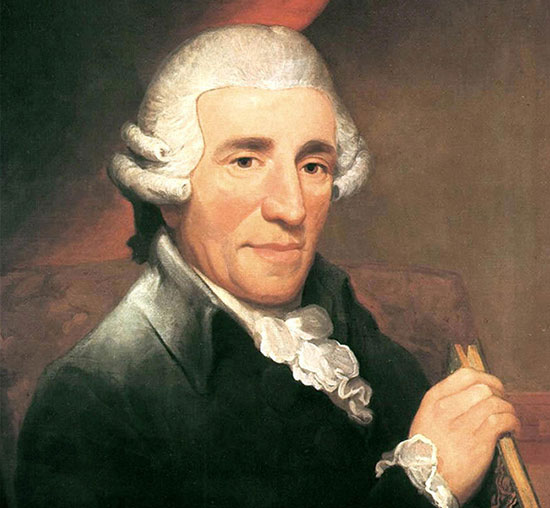提要 Overview
海顿出生的年代,正是哈布斯堡王朝日趋衰败和文化史上的巴罗克后期。在人生的道路上,他经历了玛丽亚·特蕾西亚开创的“开明专制”,而他逝世时,整个欧洲正面临着法国大革命的冲击。这种时代背景使海顿在思想上倾向当时的启蒙运动和新兴的市民阶层,然而他并不理解革命。
海顿爱好日常生活的亲切题材,长于表现人类朴实明朗的感情和乐观的信念,但不喜欢表现人的复杂的内心冲突。他不是以戏剧性而是以美妙和幽默的情趣引人入胜,快乐和充满希望构成了海顿艺术的气质。
Masses composed by Joseph Haydn are listed below. Masses are sorted using chronological indices given by New Grove. The Hoboken catalogue had also placed the masses in presumed chronological order, but further research has undermined that sequence.
海顿的弥撒曲
海顿的弥撒曲列表目录
- No. 1 in G major: 'Missa Rorate coeli desuper' (H. 22/3) (c.1750).
- No. 2 in F major: 'Missa brevis' (H. 22/1) (1750)
- No. 3 in C major: 'Missa Cellensis in honorem Beatissimae Virginis Mariae', also spuriously known as 'Cäcilienmesse' (St Cecilia) (H. 22/5) (1766–73)
- No. 4 in D minor: 'Missa Sunt bona mixta malis' (H. 22/2) (1768; Fragment)
- No. 5 in E flat major: 'Missa in honorem Beatissimae Virginis Mariae', also known as the 'Große Orgelmesse' ('Great Organ Mass') (H. 22/4) (1770)
- No. 6 in G major: 'Missa Sancti Nicolai, Nicolaimesse' (H. 22/6) (1772)
- No. 7 in B flat major: 'Missa brevis Sancti Joannis de Deo', also known as the 'Kleine Orgelmesse' ('Little Organ Mass') (H. 22/7) (c.1775)
- No. 8 in C major: 'Missa Cellensis, Mariazellermesse' (H. 22/8) (1782)
Masses nos. 9–14 form a group: each was composed by Haydn for the Esterházy family, to celebrate the name day (12 September) of Princess Maria Hermenegild, the wife of Prince Nikolaus II and a friend of the composer. The composition of these masses was Haydn's principal duty to his old employers at this time of his career.
The Heiligmesse in B-flat major, composed for the Capuchin friar Bernard of Offida, is thought to have been performed at the Feast of the Holy Name of Mary on September 11, 1796.[clarification needed That feast is on 12 September] Then there was the Paukenmesse in C major which was first performed on December 26, 1797. Thirdly, the Missa in Angustiis in D minor was performed on September 23, 1798. Fourthly, the Theresienmesse in B-flat major is from 1799, and was written for Maria Theresa of Naples and Sicily. Fifth, the Schöpfungsmesse in B-flat major was performed on September 13, 1801, and features melodies from the Creation, especially in the "Gloria". Sixth, the Harmoniemesse in B-flat major was performed on September 8, 1802, and is almost his last major work.
- No. 9 in B flat major: 'Missa sancti Bernardi von Offida', also known as the 'Heiligmesse' (H. 22/10) (1796)
- No. 10 in C major: 'Missa in tempore belli' ('Mass In Time of War'), also known as the 'Paukenmesse' ('Kettledrum Mass') (H. 22/9) (1796)
- No. 11 in D minor: 'Missa in Angustiis' ('Mass in Troubled Times'), also known as the 'Nelson Mass' (H. 22/11) (1798)
- No. 12 in B flat major: 'Theresienmesse' (named for the Maria Theresa of the Two Sicilies) (H. 22/12) (1799)
- No. 13 in B flat major: 'Schöpfungsmesse' ('Creation Mass') (H. 22/13) (1801)
- No. 14 in B flat major: 'Harmoniemesse' ('Wind-band Mass') (H. 22/14) (1802).
The Harmoniemesse 1802 was Haydn's last major work. He shortly afterward sank into debilitating illness and was unable to compose further.
海顿表面上是一位虔诚的天主教徒,在他每件手稿的开头总是写上“以上帝之名”,结尾总是签上“荣耀归于上帝”。但他虔信上帝不过是随从习俗,宗教在 他的思想与情感中并未占有重要的地位。他的最早的声乐作品之一《F大调小弥撒曲》中,“求主怜悯”乐章的音乐主题却是快乐欣喜的,著名的《圣母悼歌》充满 了人情味;而《基督在十字架上的最后七句话》这部7个乐章的管弦乐曲(后来加入独唱与合唱),给人留下的最深印象是末乐章模拟地震的画面。这些都说明海顿 的作品是面向现实、面向人生的,即使在他的宗教音乐中也是这样。他喜好田野、森林、钓鱼和打猎,他对大自然的热爱不下于莫扎特和贝多芬。
海顿的音乐之所以具有不朽的价值,因为它面向现实,面向人生,气息清新,朝气蓬勃,令人受到鼓舞;也因为它在作曲技术上奠定了欧洲古典时期的交响曲和室内乐的规范,从而形成了德奥音乐经久不衰的优良传统。

